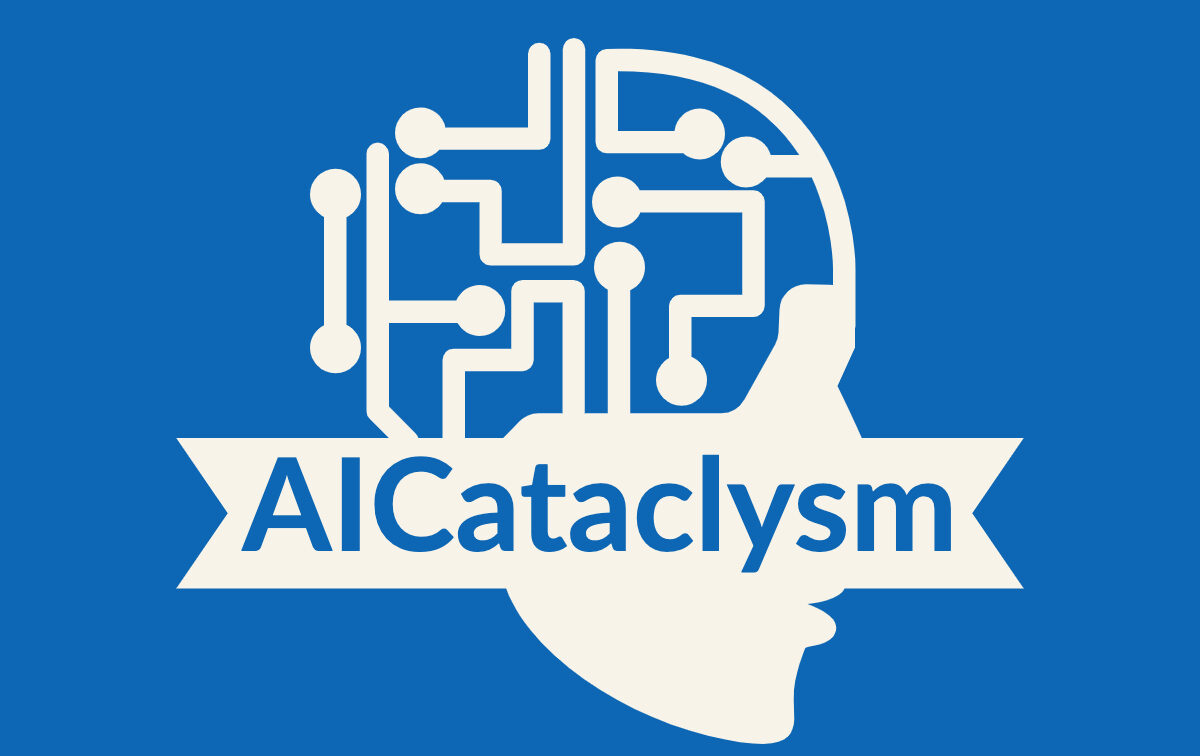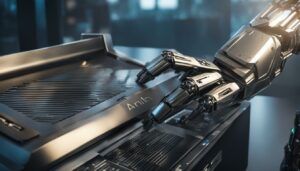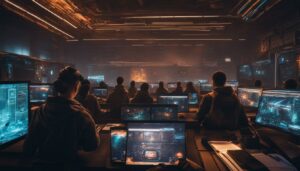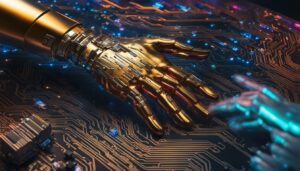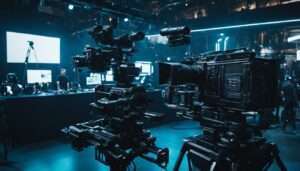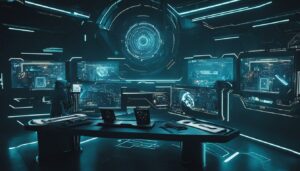Greetings! Today, I embark on a fascinating exploration into the realm of artificial intelligence (AI) and its potential for creativity. Can AI ever truly harness the power of human imagination and produce something truly groundbreaking? Let’s dive in and uncover the possibilities.
Artificial intelligence has come a long way, evolving from mere number crunching to complex pattern recognition and decision-making. Now, AI algorithms like DALL-E 2 and Adobe Firefly are being utilized as tools by artists to unlock new realms of creativity. But while AI can certainly generate innovative ideas and push boundaries, it still has its limitations in replicating the depth and emotion that define human creativity.
Key Takeaways:
- AI algorithms are now being used as tools by artists to push the boundaries of creativity.
- While AI can generate innovative ideas, it has limitations in replicating the depth and emotion of human creativity.
- AI-generated art combines human inspiration with the computational power of AI.
- The evolution of AI in creativity has sparked innovation in AI algorithms.
- AI acts as a co-creator in the creative process, opening up new avenues for exploration and innovation.
Defining Creativity and its Impact on Art and Design
Creativity is a powerful force that drives innovation and pushes the boundaries of artistic expression. In the context of art and design, creativity is the ability to come up with innovative ideas that challenge existing norms and captivate audiences. With the emergence of artificial intelligence (AI), there is a growing interest in exploring the intersection between AI and creativity.
AI’s creative abilities have opened up new possibilities for artists and designers. Through the collaboration between human artists and AI algorithms, AI-generated art has become an exciting avenue for experimentation and exploration. By harnessing the computational power of AI, artists can now create novel forms, explore new techniques, and break free from the constraints of traditional tools.
AI-generated art is a fusion of human inspiration and AI algorithms’ computational capabilities. It combines the unique vision and emotional depth of human artists with the analytical and generative abilities of AI. This collaboration has resulted in stunning artworks that blur the line between human and machine creativity.
“AI-generated art is a fusion of human inspiration and AI algorithms’ computational capabilities.”
While AI has undoubtedly expanded the creative landscape, it is important to recognize the limitations of AI in replicating the rich and nuanced aspects of human creativity. AI algorithms lack genuine consciousness, emotions, and the depth of human experience, which are often vital elements in creating impactful art. AI-generated content raises questions about originality, authenticity, and the role of human artists in the creative process.
| Pros of AI in Creativity | Cons of AI in Creativity |
|---|---|
|
|
Despite these limitations, the future of AI and creativity holds immense potential. As AI technology continues to advance, AI systems will become more adept at mimicking and augmenting human creativity. The synergy between human creativity and AI capabilities will shape a new era of artistic expression, where human artists and AI coexist harmoniously, pushing the boundaries of innovation and creating a vibrant and diverse creative tapestry.
The Evolution of AI in Creativity
Artificial intelligence (AI) has come a long way in its ability to foster creativity. Initially, AI algorithms were limited to tasks such as generating algorithmic art and composing basic melodies. However, with the advancements in machine learning, AI has evolved to delve into more intricate artistic endeavors, including painting, poetry, and music composition. The machine learning capabilities of AI have opened up new creative possibilities and sparked innovation in AI algorithms.
One of the key aspects of AI’s evolution in creativity is its ability to learn from existing artistic styles and techniques and then generate new artworks that mimic or enhance those styles. Through this process, AI algorithms can analyze extensive datasets, identify patterns, and create art that pushes the boundaries of traditional artistic expression. This innovating AI algorithms have the potential to revolutionize the art world by introducing novel forms and techniques that were previously unexplored.
Furthermore, the machine learning potential of AI allows it to continuously improve its creative abilities. As more data is fed into AI algorithms, they become better at generating innovative and unique artistic outputs. This iterative learning process enables AI to adapt and develop its creative potential over time. The combination of machine learning and AI algorithms has the potential to create an ever-evolving landscape of artistic exploration and innovation.
| AI’s Creative Potential: Innovating AI Algorithms | Machine Learning Capabilities |
|---|---|
| AI algorithms can generate algorithmic art and compose basic melodies. | Machine learning advancements enable AI to delve into more intricate artistic endeavors, such as painting, poetry, and music composition. |
| AI can analyze existing artistic styles and techniques and generate new artworks that mimic or enhance those styles. | Machine learning allows AI to continuously improve its creative abilities by learning from extensive datasets and identifying patterns. |
| AI algorithms have the potential to revolutionize the art world by introducing novel forms and techniques. | AI’s machine learning potential enables it to adapt and develop its creative potential over time. |
Overall, the evolution of AI in creativity is an exciting frontier that holds immense potential. The combination of machine learning capabilities and innovating AI algorithms allows AI to not only replicate but also augment human artistic expression. While AI may never be able to fully replicate the depth and emotion of human creativity, its continuous innovation in machine learning offers new avenues for artistic exploration and pushes the boundaries of traditional artistic expression.
AI as a Co-Creator in the Creative Process
Artificial intelligence (AI) is revolutionizing the creative process by becoming a co-creator alongside human artists. Through advanced algorithms and machine learning, AI has the ability to analyze existing works, identify patterns, and generate new ideas that may not have been apparent to human artists. This collaboration between human creativity and AI advancements has led to the emergence of AI-generated art that combines the traditions of established art styles with innovative new techniques.
By leveraging AI as a co-creator, artists are able to push the boundaries of creativity and explore exciting avenues for innovation. AI algorithms can be used to inspire new ideas, provide alternative perspectives, and enhance artistic expression. This partnership between human and artificial intelligence allows for a unique fusion of human intuition and AI’s computational power.
“AI can help artists see things that they might not have seen before, opening up new possibilities for creative exploration. It’s not about replacing artists; it’s about enhancing their capabilities and expanding the horizons of artistic expression.”
– Renowned artist and AI collaborator
The use of AI as a co-creator in the creative process also challenges traditional notions of authorship and originality. It raises questions about the role of human artists in the creation of AI-generated art and the potential impact on artistic ownership and copyright. Despite these ethical considerations, the integration of AI into the creative process has undeniably opened up new frontiers for artistic innovation.
AI’s Role in the Future of Creativity
The future outlook of AI-generated creativity is promising. As AI technology continues to advance, its creative abilities and potential for innovation will only grow. AI systems will become even more proficient at simulating human-like creativity, resulting in a richer and more diverse creative tapestry. However, it is crucial to recognize and celebrate the unique vision and emotional depth that human artists bring to their work. The future of AI and creativity lies in finding the optimal balance between human ingenuity and AI capabilities.
The intersection of AI and creativity extends beyond the realm of art and design. AI algorithms have the potential to enhance creative problem-solving and innovation in various fields such as engineering, science, and business. By leveraging AI’s computational abilities, practitioners in these fields can explore new possibilities and push the boundaries of their respective disciplines.
Overall, the harmonious coexistence of human and AI creativity offers immense potential for innovation and exploration. By embracing AI as a co-creator in the creative process, artists can unlock new levels of inspiration and push the boundaries of artistic expression. As AI continues to evolve, it is important to foster ongoing dialogue and ethical considerations to ensure responsible and meaningful integration of AI in the creative landscape.
The Limitations of AI in Replicating Human Creativity
Artificial intelligence has made significant advancements in various fields, including the realm of creativity. However, while AI algorithms have the ability to replicate certain aspects of human creativity, they still have limitations when it comes to capturing the depth and emotion that are inherent to human artistic expression.
One of the main limitations of AI in replicating human creativity is its lack of genuine consciousness and emotions. AI lacks the ability to truly understand and experience the world in the same way humans do. The depth of human experience, which often serves as the foundation of impactful art, cannot be replicated by AI algorithms alone.
Another limitation is the challenge of achieving true originality in AI-generated content. AI algorithms analyze existing works and generate new ideas based on patterns and data. While this can result in innovative pieces, there is always the question of whether AI-generated content is truly original or simply a reproduction of existing works.
“AI algorithms lack the ability to tap into human emotions and experiences, which often serve as crucial elements in creating truly impactful and meaningful art.” – AI expert
The Potential of Machine Learning in Unlocking Creative Capabilities
Despite these limitations, it’s important to acknowledge the potential of machine learning in unlocking creative capabilities in AI. As machine learning algorithms continue to advance, they have the potential to mimic and augment human-like creativity to a greater degree.
Advancements in machine learning can lead to more sophisticated AI algorithms that can understand and interpret human emotions, allowing them to create art that evokes similar emotional responses. Furthermore, as AI systems continue to learn from vast datasets and analyze patterns, they can develop innovative techniques and styles that push the boundaries of artistic expression.
| AI Creativity Limitations | Machine Learning Creative Potential |
|---|---|
| Lack of genuine consciousness and emotions | Potential to mimic human emotions and experiences |
| Challenge of achieving true originality | Creative exploration based on analyzed patterns and data |
Unleashing the Collaborative Potential
While AI may have limitations in replicating the intricacies of human creativity, it can still play a valuable role as a co-creator and collaborator with human artists. AI algorithms can analyze vast amounts of artistic data, helping artists identify patterns and generate new ideas that may not have been apparent otherwise.
By harnessing the computational power of AI in tandem with human inspiration and intuition, artists can explore new realms of creativity and achieve innovative breakthroughs. This collaboration between human artists and AI systems opens up exciting possibilities for artistic expression and pushes the boundaries of what is creatively possible.
In conclusion, while AI may have limitations in replicating the depth and emotion of human creativity, it still has the potential to augment and enhance the creative process. The ongoing dialogue and exploration of AI’s role in creativity are crucial in shaping the future of art and design, as we continue to uncover new ways to harness the power of AI in collaboration with human ingenuity.
The Future of AI and Creativity
As AI technology continues to advance, the future of AI and creativity holds immense potential. AI’s creative abilities have already shown remarkable progress, and with further advancements in machine learning, we can expect even more innovative outcomes. The ongoing synergy between human creativity and AI capabilities is set to reshape our conception of creativity and open up new horizons in art and innovation.
AI has already demonstrated its capacity to mimic and augment human creativity in various fields. From art and design to engineering and science, AI algorithms have proven their potential in enhancing creative problem-solving and innovation. The computational abilities of AI systems enable artists and practitioners to explore uncharted dimensions and push the boundaries of their respective fields.
However, it’s important to recognize that while AI can replicate certain aspects of human creativity, it still falls short in replicating the depth and emotion that are intrinsic to human artistic expression. Genuine consciousness, emotions, and the unique perspective of human artists remain essential components of truly impactful art. The future lies in finding the optimal synergy between human creativity and AI capabilities, combining the computational power of AI with the emotional depth and intentionality of human creators.
The Potential of Creative AI Advancements
With creative AI advancements, we can envision a future where AI-generated content seamlessly integrates into our cultural landscape. This integration challenges traditional notions of artistic expression and expands the possibilities of what can be achieved in art and creativity. AI-generated art, created through the collaboration of artists and AI algorithms, has already started to redefine the boundaries of artistic expression, combining established art styles with new techniques to create truly unique and innovative works.
The future outlook of AI-generated creativity promises a richer, more diverse, and awe-inspiring creative tapestry. As AI systems become even more proficient at simulating human-like creativity, we can expect new forms of inspiration and exploration into uncharted dimensions of art and innovation. The ongoing dialogue surrounding AI’s role in creativity will continue to shape and redefine the boundaries of what is possible in the creative realm.
| Advantages of AI in Creativity | Limitations of AI in Creativity |
|---|---|
|
|
The Intersection of AI and Creativity in Different Fields
Artificial intelligence (AI) is not just revolutionizing the realm of art and design, but also making a significant impact in other fields such as engineering, science, and business. The creative abilities of AI, combined with its machine learning potential, are driving innovation and problem-solving in diverse industries.
In the field of engineering, AI algorithms are being used to design and optimize complex structures. By analyzing vast amounts of data, AI can identify patterns and create innovative solutions that human engineers may not have considered. This fusion of human expertise and AI capabilities results in groundbreaking advancements and more efficient designs.
Similarly, in scientific research, AI is transforming the way experiments are conducted and data is analyzed. Machine learning algorithms can identify trends, patterns, and correlations in massive datasets, accelerating scientific discovery. AI also plays a crucial role in simulations, allowing scientists to explore complex systems and predict outcomes more accurately.
AI’s ability to analyze extensive datasets and discern patterns enables practitioners in various fields to explore new possibilities and develop innovative solutions.
In the realm of business, AI-powered tools and applications are enhancing creativity and innovation. For example, AI algorithms can analyze market trends, consumer behavior, and competitor data to provide valuable insights and facilitate strategic decision-making. AI can also automate repetitive tasks, freeing up time for professionals to focus on more creative and strategic aspects of their work.
By integrating AI into different fields, we are amplifying the creative abilities of individuals and opening up new avenues for innovation. The intersection of AI and creativity is reshaping industries, enabling us to push the boundaries of what is possible and achieve monumental growth.
| Field | AI Impact |
|---|---|
| Engineering | Optimized designs, efficient structures, innovative solutions |
| Science | Accelerated research, data analysis, simulation, prediction |
| Business | Informed decision-making, market insights, automation |
Ethical Considerations in AI-Generated Creativity
As AI continues to advance and play a larger role in the creative process, ethical considerations surrounding AI-generated creativity have come to the forefront. One of the key concerns is determining ownership, copyright, and intellectual property rights when it comes to AI-assisted creations. Since AI systems analyze existing works and generate new ideas, it becomes challenging to determine who should receive credit and compensation for these creations.
Additionally, there is a worry that AI-generated content might flood the market, potentially diluting the value of human-created art. As AI algorithms become more proficient at simulating human-like creativity, there is a need to strike a balance between encouraging innovation and avoiding mere imitation of existing works. This raises questions about the authenticity and originality of AI-generated art and its place in the artistic landscape.
The ethical discussions surrounding AI-generated creativity are crucial to ensure the fair and responsible use of AI in the creative process. By addressing these concerns, we can establish guidelines and frameworks that protect the rights of artists while also fostering innovation and collaboration between human creativity and AI advancements.
| Aspect | AI-Generated Art | Human-Created Art |
|---|---|---|
| Originality | Derives from analyzing existing works | Expresses unique human perspectives and experiences |
| Emotional Depth | Limited in replicating true human emotions | Reflects the depth and complexity of human emotions |
| Innovation | Can mimic existing styles and techniques | Challenges existing norms and pushes boundaries of artistic expression |
| Authenticity | Raises questions about the role of human artists | Embodies the unique vision and intention of the artist |
In summary, ethical considerations in AI-generated creativity revolve around issues of ownership, copyright, and the authenticity of AI-generated art. It is important to establish guidelines that ensure fair credit and compensation for AI-assisted creations while also protecting the value and originality of human-created art. By striking a balance between innovation and imitation, we can leverage the creative abilities of AI while valuing the unique perspectives and emotional depth that only human artists can bring to their work.
Balancing Innovation and Imitation in AI-Generated Art
The use of AI in the creative process has undoubtedly opened up new possibilities and sparked innovation in the world of art. AI algorithms can analyze existing art styles and techniques, and generate new artworks that push the boundaries of artistic expression. However, there is a delicate balance that needs to be maintained between innovation and imitation in AI-generated art.
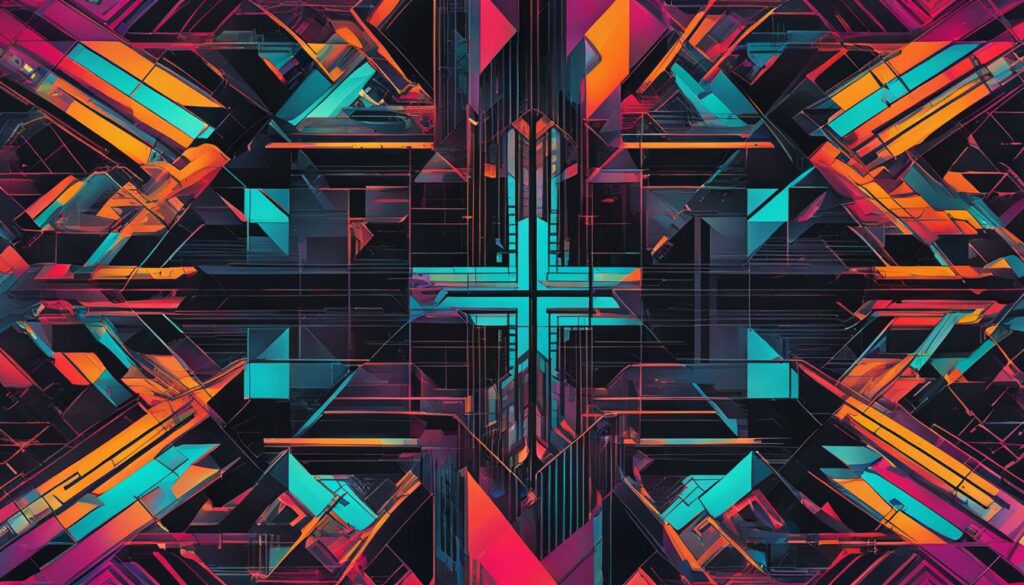
On one hand, AI algorithms have the ability to analyze vast amounts of data and replicate established art styles with remarkable precision. This can be a valuable tool for artists looking to explore different artistic traditions or experiment with new techniques. By studying and imitating the works of renowned artists, AI-generated art can pay homage to the rich history of artistic expression.
On the other hand, true innovation lies in pushing the boundaries of artistic expression and creating something entirely new. While AI algorithms can generate art that imitates existing styles, they may struggle to produce truly groundbreaking and unique creations. The essence of artistic innovation often lies in the human ability to think outside the box, challenge conventions, and bring a fresh perspective to the table.
Therefore, it is crucial for artists and creators to strike a balance between using AI as a tool for inspiration and pushing the boundaries of their own creativity. By harnessing the power of AI in conjunction with their own artistic vision, artists can create truly innovative and captivating works of art that stand out from the crowd.
The Future Outlook of AI-Generated Creativity
As we continue to witness the advancements in AI technology, it becomes increasingly evident that the future holds a groundbreaking potential for AI-generated creativity. The continuous evolution of AI algorithms and their ability to simulate human-like creativity offer exciting possibilities for the world of art and innovation.
AI’s creative abilities have already made a significant impact in the realm of art, enabling artists to explore new horizons and push the boundaries of artistic expression. With AI algorithms collaborating with human artists, we have witnessed the emergence of mesmerizing AI-generated artworks that fuse the computational capabilities of AI with the inspiration and emotions of human creators.
However, it’s important to acknowledge that AI’s creative potential is not without its limitations. While AI algorithms can mimic certain aspects of human creativity, they still lack the depth of emotion and the profound human experiences that are often at the core of truly impactful art. This highlights the indispensable role of human artists in infusing their unique perspectives and authentic emotions into their work.
Looking ahead, the future outlook of AI-generated creativity is both promising and thought-provoking. It is likely that AI systems will continue to improve their creative abilities, further blurring the lines between human and AI-generated art. This could give rise to a cultural landscape where AI-generated content seamlessly coexists with human-created art, challenging traditional notions of artistic expression and redefining the role of the artist.
In order to navigate this future with harmony and balance, it is essential to maintain a critical dialogue around AI-generated creativity. Ethical considerations surrounding ownership, copyright, and intellectual property need to be addressed to ensure fair and responsible use of AI in the creative process. Additionally, the ongoing exploration and analysis of AI’s role in creativity will shape and redefine our understanding of artistic expression in the years to come.
As we embrace the potential of AI-generated creativity, it is crucial to remember that human creativity remains a fundamental force that cannot be replicated or replaced. The integration of AI into the creative process should be seen as a tool for innovation and inspiration, enriching the creative tapestry rather than overshadowing the essence of human ingenuity.
Conclusion: The Harmonious Coexistence of Human and AI Creativity
In exploring the fascinating intersection of AI and creativity, it becomes evident that AI has the potential to enhance and augment human creativity, but it cannot replace it. AI algorithms, with their creative abilities and advancements, are valuable tools that can push the boundaries of artistic expression and inspire new forms of innovation.
However, the essence of true creativity lies in the unique vision, emotional depth, and intention that only human artists can bring to their work. AI algorithms may be able to replicate certain aspects of human creativity, but they fall short when it comes to capturing the depth, emotion, and genuine consciousness that are inherent to human artistic expression.
As we look to the future, the harmonious coexistence of human ingenuity and AI technology promises a creative tapestry that is richer, more diverse, and more awe-inspiring than ever before. The ongoing dialogue and exploration of AI’s role in creativity will continue to shape and redefine the boundaries of artistic expression.
So, while the question of whether AI can ever be truly creative is complex and multifaceted, the synergy between human and AI creativity holds tremendous potential. By embracing the unique capabilities of AI while recognizing the irreplaceable value of human creativity, we can harness the full power of this harmonious coexistence to create a future where art, innovation, and technology flourish.
